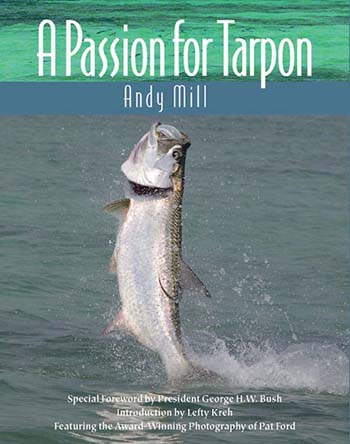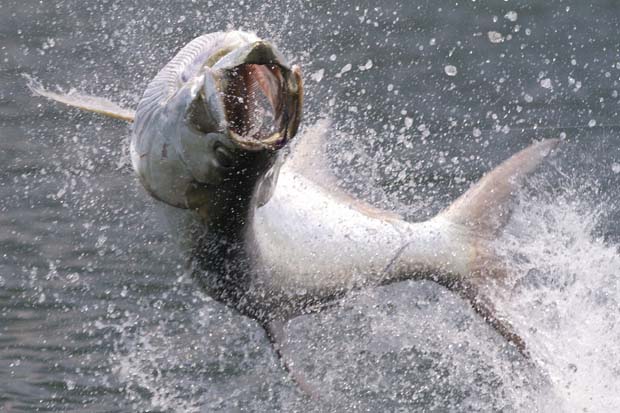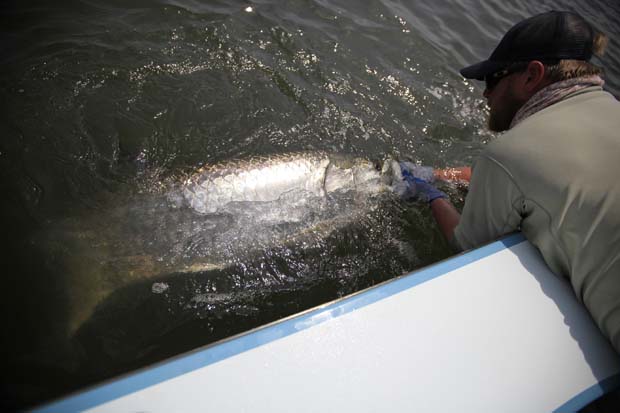
Photo by Capt. Greg Dini. The perfect fish.
It’s Tarpon Time in the Florida Keys – Where it All Happened First
Tarpon images by Capt. Greg Dini. Introduction by the editors.
If you have a passion for tarpon, we can promise you that you’ll take away from this single chapter enough to make you a better tarpon angler and, especially so, if you’re an angler with big ‘poons on the mind.
Tarpon can be a fickle thing when presented with a fly. She may turn away from it, sit tight and stare at it, follow it right up to the boat or absolutely massacre it and put on the show of a lifetime. Making the latter happen is a combination of luck, choosing a fly of interest, great casting, having the fly in the right water column, properly setting the hook, fighting the fish properly, landing it as quickly as possible and making a safe in-water release. The devil, however, is in the details of doing – so let’s examine how Andy gets there.
Part One ~ Feeding the Animal

A Passion for Tarpon book won several literary awards. To order – click here.
By Andy Mill
[dropcap]F[/dropcap]eeding the animal means making the tarpon eat your bug. My experience has convinced me that if you can read the fish, cast and present your fly correctly while staying focused on the beast, you can get it to open its mouth.
Your objective is simply to get the tarpon to bite your fly, of course, but an intriguing characteristic of tarpon is that you can almost force feed them-not almost, quite often you can. If you learn to understand tarpon and their body language, you can “own” this fish. You can induce a fish to bite your fly even when it is indifferent.
A ’poon’s willingness to be coaxed into doing something it’s not inclined to do makes it one of the greatest game fish ever to have an artificial fly thrown at it.
The best analogy I can give you relating to force-feeding a tarpon is to consider how a kitten reacts when you dangle a string in front of it. If you hit the cat on the head with the string, it’ll turn and run away. If you don’t get the string close enough. It won’t pay any attention to it. But if you toss the string out in front of the kitten in the right spot-bump it, shake it and slide it-the cat will reach out and grab the string.
It is exactly the same with feeding flies to tarpon.
All fishing is based on presentation. Quite often, when you’re trout fishing a during a hatch and you don’t have the perfect imitation of that particular insect-but you do have a dry fly or emerger with the correct profile and you’re good enough to give it a perfect drift—you can catch fish. In this scenario, you’re not feeding the fish. Here you’re hoping the fish mistakes it for food and is willing to rise up and eat your fly. Most freshwater fishing that relates to hatches is based on fooling the fish in this manner. Often though if your grasshopper gets too closely examined the trout won’t eat it. But if you skitter it over the surface the trout doesn’t have a chance to scrutinize it he’ll smash it; the same with an emerger. In this instance you’re probing the fish to grab your fly.
There are other saltwater fish besides tarpon that can be enticed to strike a bug that’s an imperfect replica of their forage by applying the correct amount of movement representing the life action of that specific bait. And then, of course, many species such as little tunny and jack crevalle will crash almost any bait that’s moving, especially if you’ve got them chummed up behind your boat.
I once fished St. Thomas in the Virgin Islands, known for its great bill fishing. Probably one of the best fish to bait-and-switch or entice a bite is a blue marlin. When they get lit up and hot they will crash almost anything. Fishing with a wonderful friend of mine, the late Jim Lambert, on his boat the Reel Tight, we successfully baited-and-switched and caught a 200-pound blue marlin on a beer can wired to a hook. This is the other end of the spectrum from a trout rising to a size 22 midge. You just hang on as a crazed monster from the deep rises up and tries to eat everything in front of it including the boat and the people in it!
Some fish when primed eat anything; others discriminatingly demand not only an exact imitation of the insect or baitfish that has their attention but also a perfect presentation that mimics the target food’s behavior.
Outside of a palola worm hatch where tarpon are feeding exclusively on the worm hatching out of a coral-rock bar, tarpon are not picky eaters. They pursue a plethora of food. You’ll see them opportunistically feeding on a school of balled uppilchards, glass minnows or in a shrimp run during a big moon. Mullet, shrimp, pilchards, glass minnows, crabs, carcasses, guts-you name it-they’re scavengers. In the dock water adjacent to fish-cleaning tables, tarpon are pigs.
That said, I’ve also seen them swim by a perfectly presented blue crab—I’m talking a crab floating on the surface 90 feet from the boat-and watched a school of 100 tarpon swim within inches of it as if it wasn’t even there. Not one biter, not even a look from a single eyeball. Yet 10 minutes later on a 1/0 hook tied with some marabou and polypropylene I had a 100-pounder flopping around the boat putting holes in the ocean the size of dump trucks.
[information]Editors’ NOTE: Republished with permission from Wildriver Press: Feeding the Animal, has been excerpted from A Passion for Tarpon by Andy Mill.
NOTE: Wild River Press reports that they are nearing selling out of the first edition of Andy Mill’s award-winning book. You may order your copy today at or by telephoning 425-486-3638.
Contact:
Thomas R. Pero
Publisher
Wild River Press
Post Office Box 13360
Mill Creek, Washington 98082 USA
Telephone: 425-486-3638




Andy Mill certainly knows a lot about catching Tarpon on the fly, and he wrote a mighty nice book on this subject. However he just got into it after he moved to Florida. There were a lot of fly fishermen fishing for Tarpon well before he did. Joe Brooks, and Stu to mention a few of the older fellows of Lefty’s generation of fly fishermen. I think they also have a lot to teach as well as Andy perspective.